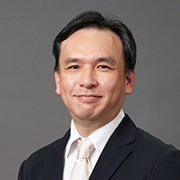Research
Information Systems Architecture Science Research Division
 KOIBUCHI Michihiro
KOIBUCHI MichihiroInformation Systems Architecture Science Research Division, Professor / Assistant Director-General
Introduction
A Dream to Design the World's Fastest Computer System Network
KOIBUCHI, Michihiro has been involved in research on computer systems and networking throughout his career. The faster computers become at processing data, the more their capabilities expand, and the more they can contribute to the development of an advanced information society. KOIBUCHI sees his mission as being a researcher in this evolution.
Early on, in an effort to increase the speed of supercomputers, he focused his study on "lossless networks" that enable high-speed data transmission without data loss. In the course of his work, he discovered that data communication delays can be significantly reduced by connecting computers randomly. His work on introducing randomness for interconnection networks in parallel computer systems, incorporating routing algorithms and wiring methods, earned widespread acclaim in the academic world. With the goal of contributing to the network design of future supercomputers, he subsequently posted (on his website) verifications of a large number of graphs that were created by experts in various fields based on his research findings.
Since that time, the purpose of use and scope of application of supercomputers have substantially changed. Most notably, supercomputers are now actively used for machine learning and other kinds of AI computation. A characteristic of AI computing is that a slight loss in accuracy does not tend to affect quality of results. However, there are concerns that supercomputers, which are typically designed to perform calculations rigorously, are not equipped to handle the explosive growth in the demand for AI computing capacity.
Recognizing that the rise of AI was changing the demands of computers, KOIBUCHI turned his mind to the study of computer algorithms and networks suitable for AI computation, unbounded by conventional wisdom. That is how his new focus of research became photonic (optical) computing.
Research on Photonic Approximate Computing
A key feature of photonic computing is multiplexing, the ability of a single device to simultaneously process multiple streams of data. Light can be used for computation as well as for communication. Theoretically, by utilizing the properties of light to the utmost, computation speeds several to several dozens of times higher than current technologies can be achieved. However, making photonic computing devices work as a part of current systems and hardware is difficult. Thus, KOIBUCHI took up the great challenge of designing a new computing system that can effectively incorporate the latest photonic computing technology.
The key to solving the issues of reliability and technical maturity is approximate computing. Approximate computing is a technology for increasing performance, such as processing speed and energy efficiency, by allowing for a certain degree of loss in computational precision.
KOIBUCHI has already developed technologies to improve the performance and energy efficiency of communications between servers in data centers. These involve a method based on parallel processing that is capable of transferring several times more data at once by cutting design margins during optical modulation while still achieving sufficiently accurate computation results.
The goal is to integrate the fruits of this research on approximate computing with photonic computing to offer a world-leading system architecture that takes advantage of the extreme performance of light.
Improving Computer Performance to Support AI Evolution
The development of algorithms and applications that incorporate research findings in approximate computing is described as "uncertainty-tolerate computing." This can be broadly understood as an attempt by a computing system to compromise the way it performs in accordance with the needs of a specific application.
KOIBUCHI is currently working on the definition of tolerable errors in relation to approximation algorithms for photonic computing, and approximation system architecture, as well as on architecture specifications. He hopes to conduct demonstration tests of approximation algorithms running on a testbed within a few years.
While photonic approximate computing will eventually be adopted for a wide variety of applications, for now, its most important role is likely to be in AI computation. Without improvements in computer performance, the advancement of AI will be held back. KOIBUCHI is confident that, in the near future, the fruits of his research on photonic approximate computing will significantly enhance AI evolution.

 Summary of NII 2024
Summary of NII 2024 NII Today No.104(EN)
NII Today No.104(EN) NII Today No.103(EN)
NII Today No.103(EN) Overview of NII 2024
Overview of NII 2024 Guidance of Informatics Program, SOKENDAI 24-25
Guidance of Informatics Program, SOKENDAI 24-25 NII Today No.102(EN)
NII Today No.102(EN) SINETStream Use Case: Mobile Animal Laboratory [Bio-Innovation Research Center, Tokushima Univ.]
SINETStream Use Case: Mobile Animal Laboratory [Bio-Innovation Research Center, Tokushima Univ.] The National Institute of Information Basic Principles of Respect for LGBTQ
The National Institute of Information Basic Principles of Respect for LGBTQ DAAD
DAAD
